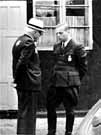
|
|
|

|

|

|

|
|
Click on an image to see a larger, more detailed picture.
|
|
|
|
|
| 1942: The "Final Solution" |

|
pg. 362 |

|
|
|
|
| |
 Mordechai Chaim Rumkowski (left), head of the Lódz Jewish Council, confers with Hans Biebow, the German head of the ghetto administration. Rumkowski sought vainly throughout 1942 to limit deportations and to turn the ghetto into an irreplaceable factory. Unaware that deportees were sent directly to their deaths at Chelmno, Rumkowski prepared his deportation list, hoping to buy time for those remaining. By the end of September, over 70,000 people had been deported. The chronicler of the ghetto wrote on September 25: "There is [almost] no one in the ghetto over the age of 65 or under the age of 10."
Mordechai Chaim Rumkowski (left), head of the Lódz Jewish Council, confers with Hans Biebow, the German head of the ghetto administration. Rumkowski sought vainly throughout 1942 to limit deportations and to turn the ghetto into an irreplaceable factory. Unaware that deportees were sent directly to their deaths at Chelmno, Rumkowski prepared his deportation list, hoping to buy time for those remaining. By the end of September, over 70,000 people had been deported. The chronicler of the ghetto wrote on September 25: "There is [almost] no one in the ghetto over the age of 65 or under the age of 10."
Photo: Al Moss / United States Holocaust Memorial Museum Photo Archive
|
 On September 4, 1942, fears of a renewed deportation from Lódz came to pass when Jewish Council leader Mordechai Chaim Rumkowski announced that 25,000 Jews under the age of ten and over 65 must be resettled outside the ghetto. From September 5 to 12 alone, at least 14,000 Jews were deported in the infamous Gehsperre (ban on movement) action. The ghetto chronicle called this period "eight days that seem an eternity!" This photograph shows a woman and child--probably mother and daughter--kissing through the fence in the ghetto's prison.
On September 4, 1942, fears of a renewed deportation from Lódz came to pass when Jewish Council leader Mordechai Chaim Rumkowski announced that 25,000 Jews under the age of ten and over 65 must be resettled outside the ghetto. From September 5 to 12 alone, at least 14,000 Jews were deported in the infamous Gehsperre (ban on movement) action. The ghetto chronicle called this period "eight days that seem an eternity!" This photograph shows a woman and child--probably mother and daughter--kissing through the fence in the ghetto's prison.
Photo: Yad Vashem / United States Holocaust Memorial Museum Photo Archive
|
|
Jews in Britain and Australia In the 1930s and 1940s, in order to keep Jews out of Palestine and because of the high degree of antisemitism in the Foreign and Colonial Offices, the British government ordered all aliens to register with the police. After France fell to the Germans, the British government ordered the internment of about 30,000 "enemy aliens" on British soil, most of whom were Jewish. About 8000 of them were deported to Canada and Australia. No matter that they were officially classified as the least dangerous of refugees; governments and native peoples treated the "enemy aliens" like pariahs. Internment and deportations ceased only after several hundred deportees were killed when their ship, the Arandora Star, was torpedoed and sunk in July 1940. Jews on another ship, the Dunera, were abused by the crew. The few Jews who arrived in Australia had to report to the police. They could not travel without police permission and could not own radios.
|
|

|

|

|

|
 September 3, 1942: At Lachva, Belorussia, more than 800 Jews battle Nazis in a revolt led by Dov Lopatyn. Most of the rebels are killed.
September 3, 1942: At Lachva, Belorussia, more than 800 Jews battle Nazis in a revolt led by Dov Lopatyn. Most of the rebels are killed.
|
 September 3, 1942: The Geneva-based World Jewish Congress learns of deportations of French Jews.
September 3, 1942: The Geneva-based World Jewish Congress learns of deportations of French Jews.
|
 September 3, 1942: Josef Kaplan, a leader of the ZOB (Jewish Fighting Organization), is arrested in Warsaw, joining another leader, Yisrael Zeltzer, in detention. When another ZOB leader, Shmuel Braslav, is stopped in the street by German troops, he is shot dead after trying to pull a knife. Another ZOB leader, Reginka Justman, is shot after being stopped while carrying the ZOB's arms cache to a new hiding place; the arms are seized.
September 3, 1942: Josef Kaplan, a leader of the ZOB (Jewish Fighting Organization), is arrested in Warsaw, joining another leader, Yisrael Zeltzer, in detention. When another ZOB leader, Shmuel Braslav, is stopped in the street by German troops, he is shot dead after trying to pull a knife. Another ZOB leader, Reginka Justman, is shot after being stopped while carrying the ZOB's arms cache to a new hiding place; the arms are seized.
|
|
|
|
|
| 1942: The "Final Solution" |

|
pg. 362 |

|
|
The Holocaust Chronicle
© 2009 Publications International, Ltd.
|
|
